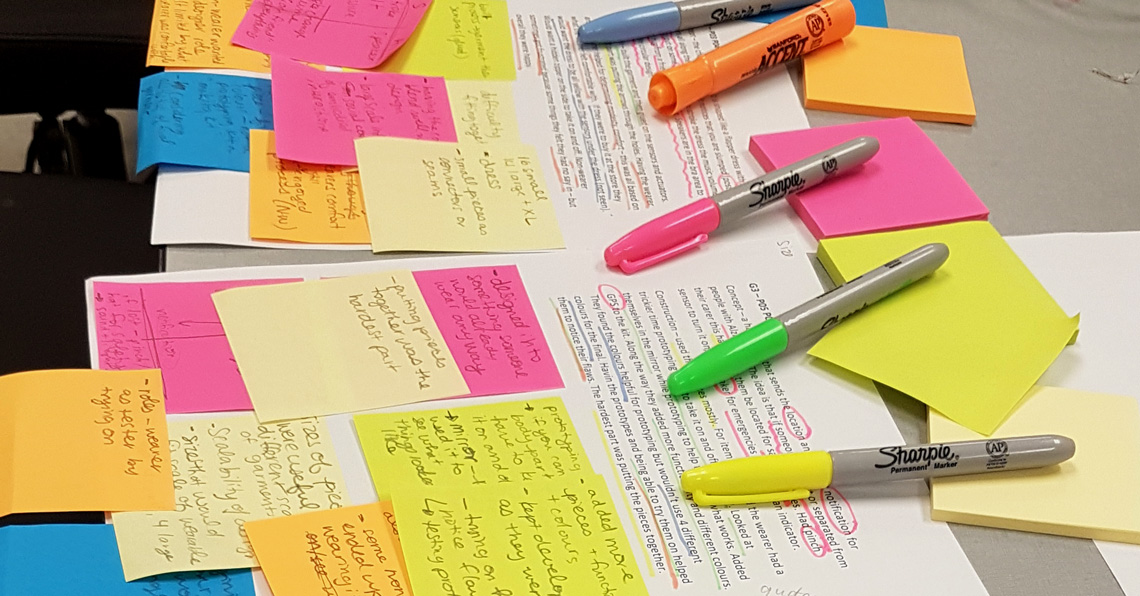Creative interactions lab @ Carleton University
Issue: XXVII.3 May - June 2020Page: 16
Digital Citation
Authors:
Sara Nabil, Audrey Girouard
How do you describe your lab to visitors? At the Creative Interactions Lab, we explore novel interaction techniques and shape: We work with flexible, soft, shape-shifting, and unconventional interactive materials to develop emerging technologies. Our lab specializes in deformable and wearable user interfaces with applications in accessibility and gaming, among others. We do this through our fablab-designed space equipped with 3D printers, laser cutters, sewing and embroidery machines, and crafting equipment and tools that help us in fabricating novel prototypes.
 |
The dynamic lab environment enables diverse and cross-disciplinary contributions. |
What is the one thing you see as most important about the work you do there? We believe that instead of a "killer app" for deformable interfaces and wearables, the key to their success resides in creating applications and devices for specialized users. So, what is most important is to work with a variety of users, such as people with visual impairments, people with mobility impairments, people living with repetitive-strain injuries, and everyday users, to co-design and evaluate prototypes that are useful for them.
 |
Panoramic view of our makerspace. |
How many people are in the lab, and what is the mix of backgrounds and roles? We are a proud, diverse group of typically 10 researchers with a large mix of backgrounds and expertise. Stretching from digital media, design, and computing to humanities, criminology, and sociology, the CIL is quite multidisciplinary. In addition to undergraduate students that call the lab home over summer, we have typically three to four HCI or IT master's students, a few IT Ph.D. students, a postdoctoral fellow, and one faculty member. Our variety of backgrounds is our main asset, as we integrate everybody's expertise in each of our own projects and accumulate our fabrication and prototyping knowledge over time. Our collaborative work environment and regular lab meetings strongly contribute toward this.
 |
Designing an ideation method for e-textile wearables. |
What is one feature of your lab that you could not do without? Our strength is that we have a great lab space, yet we also get out! Inside, a treasure-box lab full of prototyping equipment, tools, and materials defines the CIL, how we work and learn through making, and what research questions we tackle. We work together, get creative, and solve puzzles collectively. People regularly bring homemade food (let's be honest, desserts!) to our lab meetings, and we even 3D printed our very own CIL cookie cutter to accompany our sweets obsession.
Outside, the Rideau River right by our door is almost an extension of the lab, expanding our space and our creativity. Outside excursions, off-site meetings, and food outings enable mingling, which leads to collaboration and engagement with each other, an overall healthy lab dynamic, and work-life balance for everyone.
Outside excursions, off-site meetings, and food outings enable mingling, which leads to collaboration and engagement with each other.
 |
Engaging in the qualitative analysis of a co-design user study. |
 |
Food is an integral part of our lab. L-to-R: leftover sucre-à-la-crème; CIL-themed banana bread; CIL sugar cookies; fresh scones for the lab meeting. |
What is a unique feature of your lab? We believe in continuity. Unlike other labs that take on islanded, dissociated projects that may have a life span limited by its primary investigator's presence and interest, we pursue the exploration of a research opportunity and the potential of new technology to the fullest extent. As we are a proud, collaborative group that builds on each other's work, our research projects live beyond individual lab residencies. For example, we have a few strands of projects—all driven by novel interaction techniques—that build on top of one another, starting off with conceptualization and then on to better prototypes that utilize the latest technologies (i.e., sensors or actuators), often later with another researcher. Of course, this creates the challenge of publishing such accumulative work in today's research world, which expects "novel concepts" and/or a "significant contribution" in every piece of work. However, we believe that the deeper investigation and continued uptake of research projects provides the community with greater understanding and insight toward boundary-pushing and life-changing technologies.
 |
A fall outdoor lab meeting. |
Do you collaborate with other HCI researchers at your institution? Carleton is home to 27 faculty members with direct and indirect HCI expertise, from 13 different schools and departments, including architecture and industrial design, computer science, business, psychology, and journalism. This creates an overall rich research environment, with many collaborations, co-supervisions, invited speakers, workshops, and course offerings. It allows students and faculty members the opportunity to expand their knowledge beyond their narrow domain expertise. We like to be part of a rich HCI ecosystem.
 |
One of the CIL Ph.D. students working by her inspiration board and prototypes. |
Copyright held by authors
The Digital Library is published by the Association for Computing Machinery. Copyright © 2020 ACM, Inc.


